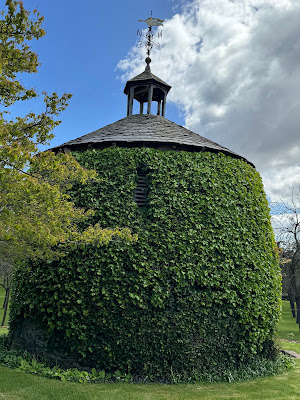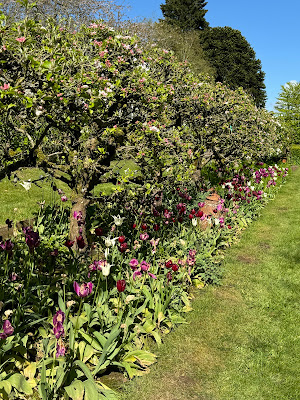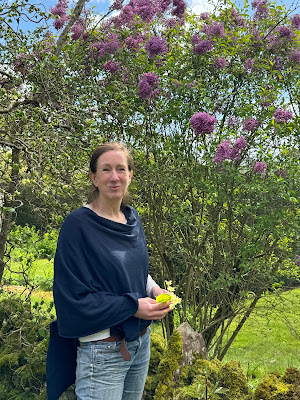I was in rural Herefordshire a few days ago for a press event for twenty members of the garden press and influencers at Stockton Bury Gardens which is open to the public. I've longed to see these gardens for quite a while, so how did they measure up to the rather high expectations I had?
Springtime at Stockton Bury charms you immediately as you enter and face eight acres of cider orchards lying between garden and farmland.

Tamsin Westhorpe is both curator and a gardener here, and a fascinating and funny host for the day as she enthuses us all with how five generations of her family have lived here, developed the garden, and what it's like opening the garden to the public.
In my mind, Tamsin is a human dynamo, as she combines her work and passion for this place as well as judging RHS shows, writes books and has edited several national horticultural magazines.
At the start our tour, there's excitement as I see the dovecot., and let me tell you, this is not just any dovecot. It dates from the time of King Henry 1(1068 - 1135)
and the interior is just as impressive. I can't help but admire the sheer craftsmanship of those who built in all those years ago.
I was less thrilled to hear about what happened inside. Doves were bred all year around to eat, they were an important source of protein in the Middle Ages. The farm workers would ring a bell, all the adult doves would fly out, leaving the baby doves alone, where they would be taken and cooked.
Into the gardens beyond, there were views to delight at every turn or gateway....
I adore the intimate little garden spaces, such as the piece of garden which Tamsin's grandmother claimed as her own. A calm, sheltered haven for the bees, full of fritillias,

plus a a little space to sit , decorated with painted botanical images, which once an outside lavatory.
Moving down the garden, there's a glimpse of Uncle Raymond's vegetable and fruit garden. He's the owner of Stockton Bury
A long line of espalier apple trees, underplanted with tulips and love in the mist, provide a boundary between kiwi fruits, peaches, cherries, soft fruit and the long path towards the Dingle.

As we move back towards the dovecot, I spy a small bed in a sheltered corner with pristine, oh so pretty white double headed flowers. I'm immediately enchanted by these Aenemones Vestal and want a huge clump or three for my garden. Apparently they are difficult to get hold of, so I may have to sulk for a while.....
It's time to venture back into the garden to forage with Liz Knight, whose new book ‘Buds and Blossoms’has just been published. I have never foraged for anything in my life, so being shown flowers (primrose and lilac anyone?) that we could eat, leaves, such as magnolia and hosta, and given these to try were a sensory revelation. Liz is so engaging too, romping through Roman and Chinese history to highlight how these plants were eaten as well as why these blossoms are so good for us.
/
A delicious lunch follows in the cafe (hosta quiche, which tasted just like asparagus) and a nutty, flowery roulade which delights too.
While we are sitting, there's a lively discussion on open gardens with Tamsin and James Madge, who is head gardener of the Laskett, the nearby garden created by Sir Roy Strong and his wife. How can gardens attract more visitors, what do visitors want and how can gardens generate more income without losing their ethos and sense of place.
Later, wandering around the grounds on my own, I meet up with Raymond Treasure (Uncle Raymond), who alongside Gordon Fenn has lovingly created this garden over the last fifty years. Funny, quirky and a real character, he is devoted to this patch of Herefordshire,
No wonder, this is a very special garden, unspoilt by signs forbidding you to walk on the grass or suchlike which are seen at so many gardens these days. There is a wonderful cafe which is run by Tamsin’s sister Connie , using an old tithe barn with freshly cooked food, some from the garden.
There’s no pressure, no rush, you can wander at will, take time to appreciate how unique this garden is. There's a timeless quality here, an air of bucolic bliss perhaps a legacy from when this was a monastic farm hundreds of years ago.
As I reluctantly prepare to leave, I'm so pleased to get the chance to see Stockton Bury in the spring, so lush, green, full of colour and the promise of summer to come. It really is a garden for all seasons. Yes I will back as soon as I can, to see Stockton Bury, and to explore Herefordshire too - it’s a beautiful county.
Stockton Bury is open now from Wednesdays to Sundays 11am-
4.30pm until 29th September, excluding bank holiday Mondays.














